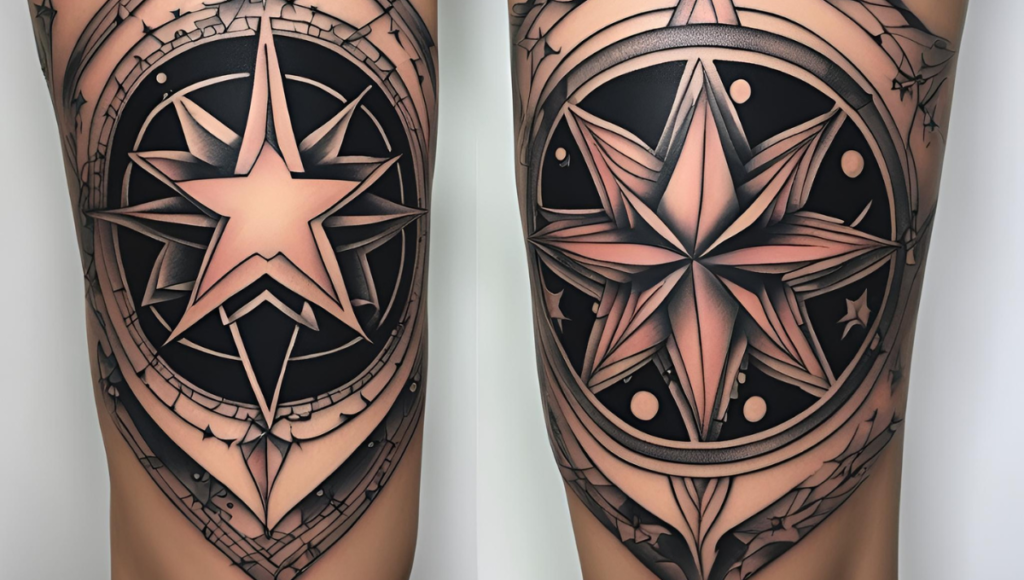Introduction
Tattoos have been a significant part of human culture for centuries, serving as a form of self-expression, identity, and symbolism. Among various tattoo designs, star tattoos hold a special place due to their deep meanings and aesthetic appeal. One particularly intriguing placement for a star tattoo is on the knee. Many people opt for a star tattoo on the knee for various personal, cultural, and traditional reasons. This article will explore the meaning behind a star tattoo on the knee, its historical significance, variations, and cultural perspectives.
The Symbolism of a Star Tattoo
Stars are celestial bodies that have been admired and studied for thousands of years. They symbolize guidance, hope, ambition, and enlightenment. Many people get star tattoos to represent their journey through life, the pursuit of dreams, or as a tribute to their beliefs.
The specific placement of a star tattoo on the knee adds another layer of meaning to this symbol. The knee is an unusual but meaningful tattoo location, often associated with movement, strength, and resilience. When combined with the symbolism of a star, it can signify overcoming struggles, perseverance, or a rebellious spirit.

Historical Significance of Knee Tattoos
Tattooing has been practiced in various cultures across the globe, with knee tattoos often holding special meanings in different societies. Some of the most significant influences come from maritime traditions, prison culture, and gang affiliations.
1. Maritime and Nautical Meanings
Sailors have long used tattoos as symbols of protection and guidance. The Nautical Star, a popular star design, was historically tattooed on sailors to help guide them safely through their journeys. A star tattoo on the knee in a nautical sense could symbolize always moving forward or never staying down, as sailors were always traveling the seas.
2. Prison and Gang Culture
In prison tattoo culture, a star tattoo on the knee can signify defiance and resistance to authority. It is often associated with the phrase, “I kneel to no one,” meaning the wearer refuses to submit to any higher power or authority. This particular meaning is popular in Eastern European criminal organizations, especially within the Russian prison system, where tattoos hold specific hierarchal meanings.
3. Rebellion and Anti-Establishment Sentiments
For many people, getting a star tattoo on the knee represents rebellion and nonconformity. It serves as a visual statement that the wearer does not bow down to societal expectations, norms, or authoritative figures. This meaning is often linked to punk and underground subcultures.
Different Designs and Their Meanings
A star tattoo on the knee can come in various styles, each carrying a unique interpretation. Here are some popular designs and their meanings:
1. Nautical Star Tattoo on the Knee
- Represents direction and guidance
- Common among sailors and those seeking purpose in life
2. Five-Pointed Star Tattoo on the Knee
- Can symbolize balance, harmony, and protection
- Sometimes linked to the five elements (earth, water, fire, air, and spirit)
3. Black Star Tattoo on the Knee
- Often used as a symbol of mystery or mourning
- May represent strength and overcoming hardships
4. Russian Star Tattoos on the Knee
- Associated with the Russian prison system
- Indicates high rank in criminal organizations or refusal to kneel before authority
5. Shooting Star Tattoo on the Knee
- Symbolizes fleeting moments, ambitions, and making wishes
- Represents a pivotal moment in the wearer’s life
6. Tribal Star Tattoo on the Knee
- Often linked to indigenous cultures and spiritual beliefs
- Can signify protection and a connection to ancestry
Who Gets a Star Tattoo on the Knee and Why?
People from various backgrounds choose to get star tattoos on their knees for deeply personal reasons. Some of the most common motivations include:
1. Personal Strength and Perseverance
- Overcoming personal struggles
- A reminder to keep moving forward despite challenges
2. Cultural or Traditional Beliefs
- Rooted in heritage or family customs
- Following the tattoo traditions of specific groups (e.g., sailors, gangs, or indigenous tribes)
3. Symbol of Freedom and Independence
- Representing nonconformity and anti-establishment ideals
- A way to express individuality and personal beliefs
4. Memorial or Tribute Tattoos
- Honoring a lost loved one
- Marking an important event or milestone in life
Placement Significance: Why the Knee?
Tattoos on the knee are relatively rare, making them a unique choice. Here are some reasons why individuals choose this specific placement:
- Pain Tolerance: Knee tattoos are known to be painful due to the bone structure and nerve endings in the area.
- Visibility: Depending on clothing choices, a knee tattoo can be easily concealed or displayed.
- Symbolism: The knee is associated with bending and submission, making a star tattoo on the knee a powerful statement of defiance or resilience.
- Aesthetic Appeal: Many people find knee tattoos visually striking, as they wrap around the joint in an artistic manner.
Things to Consider Before Getting a Star Tattoo on the Knee
1. Pain Level
Knee tattoos are among the most painful places to get inked due to the thin skin, lack of fat, and proximity to the bone. Be prepared for discomfort and a longer healing time.
2. Healing Process
Due to the constant movement of the knee joint, healing can take longer than other body parts. Proper aftercare is essential to prevent fading or infection.
3. Cultural Sensitivity
Some star tattoos on the knee carry strong cultural or criminal connotations. It is crucial to research the design thoroughly to avoid unintended associations.
4. Long-Term Commitment
Tattoos are permanent, and knee tattoos can fade faster due to frequent movement and exposure. Regular touch-ups may be required.
Conclusion
A star tattoo on the knee is more than just a stylish body art choice—it carries deep meanings rooted in history, culture, and personal beliefs. Whether symbolizing strength, rebellion, guidance, or defiance, this tattoo placement holds significance for those who choose it. However, it is essential to consider its pain level, healing process, and cultural implications before committing to the design.




